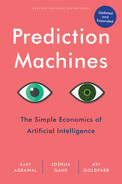Preface to the Updated Edition
It has been five years since we were working on the first edition of Prediction Machines. That book was written just five years after University of Toronto researchers were able to demonstrate that deep learning methods could significantly outperform people in describing images. That moment marked the new and perhaps most significant advances in artificial intelligence to date. Over the course of the decade, AI has moved from nowhere to all over the place. We can see many of these advances—such as how our phones can recognize our faces even with glasses or masks on. Others we do not see, such as the use of AI to more easily assess the quality of goods shipped on international supply chains. Now is a good opportunity to revise our best-selling book to ensure it is keeping up with the times.
Our perspective in analyzing AI and its impact for businesses comes from economics. As economists, we strip away the fanfare and try to reduce exciting technologies to their less exciting essence. We showed that these new advances in AI were, in one sense, just an advance in the statistics of prediction. But they took previous statistical methods to another plane. In reducing the cost of predicting things, they found applications where prediction was already used (e.g., the predictions of financial institutions) but also where people didn’t realize prediction could be used (e.g., in image classification or self-driving vehicles). The past five years have only reinforced the usefulness of the careful application of economics for businesses.
We have now had the benefit of seeing many businesses take the tools we provide here and develop new applications for AI prediction. But we have also gained new insight into some of the associated challenges. Hence, we have added two new chapters to the book that delve deeper. One describes how prediction is a substitute for other ways of managing risk (like insurance), and another shows that the stakes associated with the decision really matter when you are thinking of relying on prediction machines that are not perfect (they are just predictions after all). We believe these will help you carefully sort out the right entry points for AI in your business and make your next decade a profitable and innovative one.
We had another new insight since writing Prediction Machines. Not only do advances in AI lower the cost of predictions, but they decouple prediction and judgment—two primary inputs to decision-making. This decoupling will become the cornerstone of new system-level solutions. Lower-cost predictions enable point solutions that impact a single decision or action, whereas decoupling enables solutions that impact systems of related decisions. This insight is like a Russian nesting doll. Each time we unpacked the main idea, we found another one inside. So, we wrote a new book as a companion to this one. In Prediction Machines, we explain the simple economics of AI and describe how the technology is used for point solutions. In Power & Prediction, our new book, we explain the economics of interrelated decision-making and describe how to use the technology for system-level solutions. System solutions are often difficult for incumbents to implement because they shift decision rights, and thus power, from some people or companies to others. As a result, there is resistance to this type of change. To date, most investment in AI has focused on point solutions. We anticipate that will change—and thus AI will become more disruptive. So, buckle up.
—Ajay Agrawal, Joshua Gans, and Avi Goldfarb, 2022
